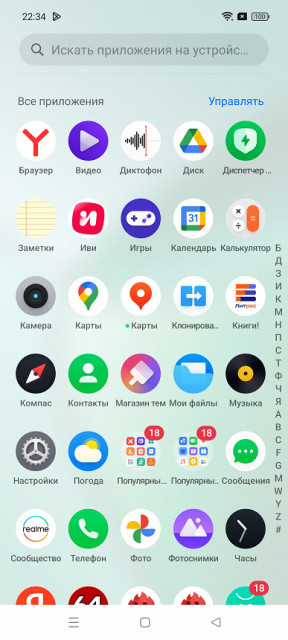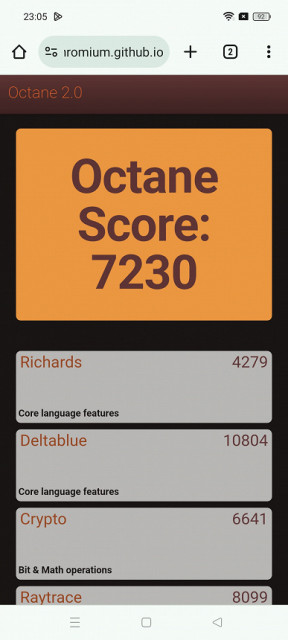Realme has added a new model to its 12th-generation smartphone series — Realme 12+ 5G. This is a more affordable and simplified mid-range option compared to the older model in the line, Realme 12 Pro+.

Key Features of Realme 12+ 5G (Model RMX3867)
- SoC Mediatek Dimensity 7050, 8 processor cores (2×Cortex-A78 @2.6 GHz + 6×Cortex-A55 @2.0 GHz)
- GPU Mali-G68 MC4
- OS Android 14, Realme UI 5.0
- Touchscreen AMOLED, 6.67″, 1080×2400, 20:9, 395 ppi, 120 Hz
- RAM 8/12 GB, internal memory 256/512 GB
- Support microSD (combined slot)
- Support Nano-SIM (2 pcs.)
- Networks 2G GSM, 3G WCDMA, 4G LTE, 5G
- GPS, GLONASS, BDS, Galileo
- Wi-Fi 6 (2.4 and 5 GHz)
- Bluetooth 5.2, A2DP
- NFC
- USB 2.0 Type-C, USB OTG
- 3.5 mm audio output for headphones
- Cameras 50 MP + 8 MP (wide-angle) + 2 MP, video 4K@30 fps
- Front camera 16 MP
- Proximity and light sensors, magnetic field, accelerometer, gyroscope
- Fingerprint scanner (under the screen)
- Battery 5000 mAh, charging 67 W
- Dimensions 163×76×7.9 mm
- Weight 190 g
Appearance and ease of use
The Realme 12+ 5G smartphone comes in a cardboard box decorated in the brand's signature colors.

The kit includes a 67W power supply, a connecting cable and a protective case.

Realme 12+ 5G has a modern design in terms of shapes, but has a controversial design. The body has a large round attachment with cameras, which disrupts the elegance and spoils the overall look of the cute body of the new product.

The rest of the smartphone's design is modern and relevant. There are no streamlined shapes or tapered sides; all panels are flat, and the side edges are wide. The smartphone fits securely in the hand, but the sharp transitions from the side frame to the front and back panels may not please everyone.
The materials are not premium. The frame on the sides is made of metallized plastic that imitates chromed metal. The back is made of a material resembling eco-leather, matte and rough, which does not slip and does not leave fingerprints. However, how quickly this porous material will lose its appearance, only time will tell. Also, the coating on the sides may eventually begin to peel off from constant contact with hands.

The smartphone is not very heavy, its weight does not exceed the psychological threshold of 200 grams, which is already not bad. The complete case is the most ordinary — flexible and transparent.

The side buttons are large, wide, with a short, elastic stroke. They are conveniently located on one side right under the fingers.

A single front camera lens is installed behind a round cutout in the screen matrix in the center of the top edge.

The fingerprint scanner is located under the bottom of the screen glass. It is an optical scanner that works accurately, but not very fast. There is a tendency to borrow fashionable but inconvenient features from the top segment to the middle one, which is disappointing. I would like to see the scanner in a more convenient place — on the side, right under the finger, and not where the hand holding the smartphone reaches, which is quite inconvenient.

The sliding tray can accommodate two Nano-SIM cards or replace one of them with a microSD memory card.

The bottom end houses a speaker, microphone and USB Type-C connector.

The top edge of the smartphone is equipped with an additional microphone and a second speaker for stereo sound. It is nice that the 3.5 mm audio output has been preserved, although its placement on the top edge seems unusual, since only a few models in the history of smartphones have used such a location.

Realme 12+ 5G is available for sale on the Russian market in two colors — beige and green. The case is protected according to the IP54 standard, which provides only light protection from splashes and raindrops.

Screen
The Realme 12+ 5G smartphone features a 6.67-inch AMOLED display with a resolution of 1080×2400 (20:9), protected by flat glass. The physical dimensions of the screen are 70×155 mm, and the pixel density is 395 ppi. The frame around the screen is 3 mm wide on the sides, 3.5 mm at the top and 5 mm at the bottom, which makes it quite wide. The display supports a refresh rate of 120 Hz.
The front surface of the screen is made of a glass plate with a mirror-smooth surface that is resistant to scratches. The anti-glare properties of the screen are better than those of the Google Nexus 7 (2013), and the oleophobic coating effectively repels grease, which makes it easier to remove fingerprints and slows down their appearance compared to ordinary glass.
With manual brightness adjustment and a white field displayed on the screen, the maximum brightness is about 560 cd / m², and in bright sunlight it can reach 1125 cd / m² (which is also applicable when playing HDR video). High maximum brightness contributes to good readability in the sun, especially due to excellent anti-glare properties. The minimum brightness is 2 cd / m², which allows you to comfortably use the screen in complete darkness. Automatic brightness control, controlled by a light sensor, is located under the screen closer to the top edge. In automatic mode, the brightness changes depending on the lighting conditions. With default settings, auto-brightness reduces the brightness to 7 cd/m² in complete darkness (which may be a bit dark), sets the brightness to 110 cd/m² in office lighting (approximately 550 lux) (good enough), and reaches 1125 cd/m² in bright sunlight (maximum, as needed). After slightly increasing the brightness in the dark, we got the following values: 20, 140 and 1125 cd/m² (optimal). Overall, the auto-brightness function works adequately, allowing you to adjust the screen depending on your individual requirements.
At any brightness level, there is noticeable modulation at a frequency of 12 or 480 Hz. Below are graphs of the dependence of brightness (vertical axis) on time (horizontal axis) for several brightness settings in 60 Hz mode.

At high brightness, the modulation amplitude is insignificant, and no visible flickering is observed. However, when the brightness is significantly reduced, modulation with a large relative amplitude and high duty cycle appears, which can manifest itself in stroboscopic effect tests or with rapid eye movement. Such flickering can cause fatigue depending on individual sensitivity. However, the high modulation frequency (480 Hz) and differences in the modulation phase across the screen area help to reduce the negative impact.
A mode with an increased refresh rate of up to 120 Hz is available in the screen settings:

In 120 Hz mode, the smoothness of scrolling menu lists increases significantly. The modulation character does not change fundamentally:
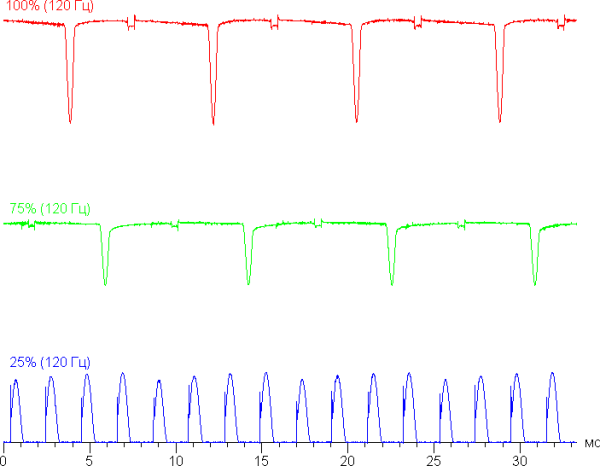
The screen is equipped with a Super AMOLED matrix — an active matrix on organic light-emitting diodes. The full-color image is formed by subpixels of three colors: red ®, green (G) and blue (B). At the same time, the red and blue subpixels are twice as small as the green ones, which can be designated as RGBG. This is confirmed by a fragment of a microphotograph:
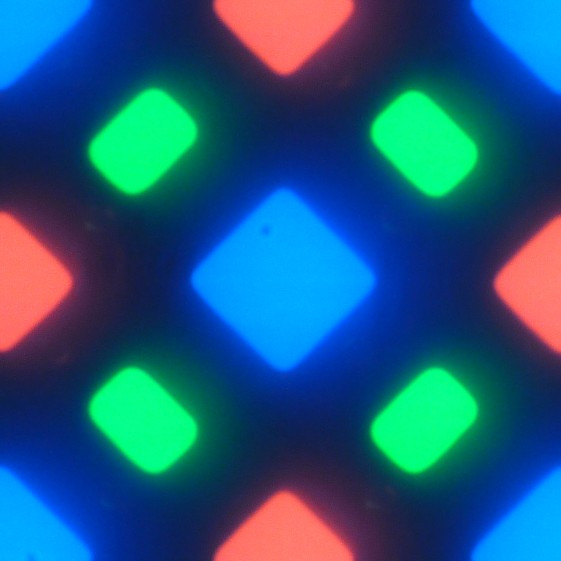
In the fragment above, you can see 4 green subpixels, 2 red (4 halves) and 2 blue (1 whole and 4 quarters). These elements can be repeated to cover the entire screen without gaps or overlaps. Matrices of this type are called PenTile RGBG. The manufacturer specifies the screen resolution by green subpixels, which makes the resolution by red and blue subpixels slightly lower. Although such matrices have some unevenness of contrast borders and artifacts, high resolution minimizes their impact on image quality.
The screen provides excellent viewing angles. The brightness when viewed at an angle is noticeably reduced compared to the Nexus 7, but the decrease in brightness on this screen is less pronounced. Therefore, even with the same brightness, the smartphone screen looks brighter (in comparison with LCD screens), since you often have to look at the screen at a slight angle. White color acquires slight rainbow hues at a slight deviation, but black color remains truly black at any angle, which makes the contrast parameter inapplicable. For comparison, we present photographs with a white field on the screens of a smartphone and another device, where the brightness is set at 200 cd/m², and the color balance of the camera is set to 6500 K.

Note the good uniformity of brightness and color tone of the white field.
And the test image:

The colors on the smartphone screen look oversaturated (pay attention to the tomatoes, bananas, napkin and face color), and the color balance is noticeably different. We remind you that the photo is not a reliable source of information on the quality of color rendering and is provided for illustrative purposes only. In particular, the pronounced reddish tint of white and gray, which is visible in the photos of the screen, is not noticeable when looking directly at the screen, which is confirmed by hardware tests using a spectrophotometer. This is due to the fact that the spectral sensitivity of the camera matrix does not fully coincide with the characteristics of human vision.
The photo was taken in the «Bright colors» profile, which is installed by default. In total, four profiles are available on the screen:
When you select the Cinematic profile, the color balance changes — the shades become warmer:

In the case of the Excellent profile, the color saturation is even higher:

Whereas in the case of the Natural profile the situation is better:


In some conditions, such a step can cause the appearance of trails that follow moving objects.
Analysis of the gamma curve, constructed using 32 points with an equal interval by shade of gray, showed that there are no significant deviations in either highlights or shadows. The exponent of the approximating power function is 2.22, which is close to the standard value of 2.2. The real gamma curve also deviates little from the power dependence:
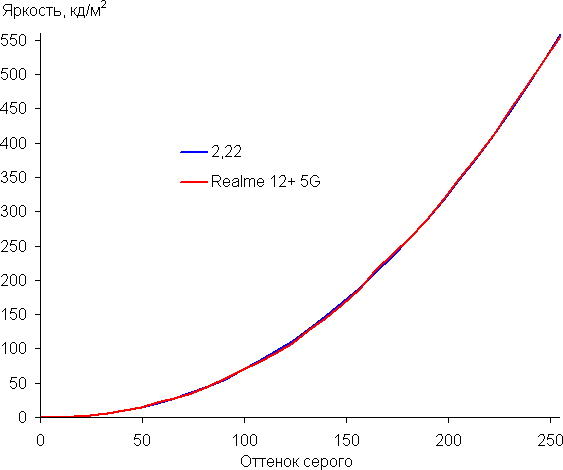
Let us recall that for OLED screens, the brightness of image fragments changes dynamically depending on the nature of the displayed image. This leads to a slight decrease in brightness for light images. Therefore, the obtained dependence of brightness on hue (gamma curve) may not exactly correspond to the gamma curve of a static image, since the measurements were taken with sequential output of gray shades almost on the entire screen.
The color gamut in the «Vivid colors» and «Cinematic» modes is wider than sRGB and close to DCI-P3:
In the case of the Magnificent profile, the reach is even wider:

When you select the Natural gamut profile, it is compressed to the sRGB limits:

In the case of the Excellent profile, the component spectra are very well separated, which allows for wide coverage:

In the case of the Natural profile with maximum coverage correction, the color components are mixed with each other to a significant extent:

On wide-gamut displays, sRGB-optimized images may appear oversaturated without proper color correction. Therefore, for viewing movies, photos, and other natural images, it is better to select the Natural profile. The Vivid (or Cinematic) profile is suitable for DCI-P3 content, which is used in digital cinematography but is less common in everyday life.
After selecting the Natural profile, the grayscale balance is very good — the color temperature is close to the standard 6500 K, and this parameter remains stable over a significant part of the grayscale, which improves the perception of color balance. The deviation from the black body spectrum (ΔE) is less than 3 units, which is considered a good indicator even for professional devices, and the spread of this characteristic is also small.


On wide-gamut displays, sRGB-optimized images may appear oversaturated without proper color correction. Therefore, for viewing movies, photos, and other natural images, it is better to select the Natural profile. The Vivid (or Cinematic) profile is suitable for DCI-P3 content, which is used in digital cinematography but is less common in everyday life.
After selecting the Natural profile, the grayscale balance is very good — the color temperature is close to the standard 6500 K, and this parameter remains stable over a significant part of the grayscale, which improves the perception of color balance. The deviation from the black body spectrum (ΔE) is less than 3 units, which is considered a good indicator even for professional devices, and the spread of this characteristic is also small.

Bright light can disrupt your circadian rhythm, but this can be easily fixed by reducing the brightness to a comfortable level. There is no point in distorting the color balance by reducing the blue contribution, as this does not make sense.
This device probably does not support DisplayPort Alt Mode for USB Type-C, which means that there is no way to output images and sound to an external device via the USB port.
The final review: the screen has a very high maximum brightness (up to 1125 cd / m²) and excellent anti-glare properties, which ensures comfortable use even in bright sunlight. In complete darkness, the brightness can be reduced to a comfortable 2 cd / m². The automatic brightness adjustment mode works adequately. The advantages of the screen include an effective oleophobic coating, support for a refresh rate of 120 Hz, a color gamut close to sRGB and a good color balance with the right profile. The OLED screen also offers true blacks, uniformity of the white field and less drop in brightness when viewed from an angle. The main drawback is flickering at low brightness, but overall the screen quality is very high.
Camera
The Realme 12+ 5G smartphone has three rear cameras and one front camera.
- 50 MP, 1/1.95″, f/1.9, 26 mm, PDAF, OIS (main)
- 8 MP, 1/4.0″, 1.12 µm, f/2.2, 16 mm, 112˚ (wide-angle)
- 2 MP, f/2.4 (macro)
- 16 MP, 1/3.0″, f/2.5, 24 mm (selfie)
The main camera has phase detection autofocus and optical image stabilization. By default, it takes photos in 12.5 MP resolution with 4-in-1 pixel binning, but you can also choose to shoot in full 50 MP resolution. Although 50 MP photos should theoretically have better detail, their processing often leaves much to be desired: noise is not completely removed, which leads to the loss of fine details and unnecessary sharpening. Therefore, it is better to use the standard 12.5 MP mode, as photos in this resolution look better and more balanced.
In good lighting, the Realme 12+ 5G takes quality photos for a mid-range smartphone. The picture is characterized by good sharpness, clarity, contrast, and volume. Details are well-detailed, without significant highlights or underexposed areas in the center of the frame. Although there may be blurring at the edges and added contour sharpness, overall the photos are bright, rich, and clear.
Here are additional examples of photos from the main camera in automatic mode:
But the night shots have nothing to brag about. There are few details, the lighting is distorted.

The zoom on this smartphone is purely digital. It is not entirely clear how exactly the zoom is achieved, but the result is a lack of additional detail in the zoomed-in image. Digital zoom up to 20× can be useful if you do not want to manually zoom in on the screen with your fingers.
The wide-angle module does its best, but frankly, its capabilities are limited. The blurriness of the image is compensated by excessive contour sharpness, which makes the pictures acceptable on the smartphone screen, but their real-world value is questionable. In any case, the colors in the wide-angle shots correspond to the main ones, and geometric distortions are minimal.
A separate module with a very low resolution is allocated for macro photography. We thought that these «plugs» had already gone out of fashion among Chinese developers, but apparently not yet.
The smartphone shoots video in 4K resolution at 30 frames per second, the processor does not support more frames. The video has a slight stroboscopic effect and roughness in the details, but overall the picture is rich and contrasting. However, there is no stabilization, so shooting on the move will be problematic. To record at 60 frames per second, you need to lower the resolution to 1080p, where electronic stabilization is activated, but this leads to a significant loss of detail and a soap effect. As a result, the video quality remains average, but the sound is recorded well.
The selfie camera copes with the tasks well: it clearly highlights the object, does not distort colors and conveys a sufficient amount of detail without overexposure.

Telephone and communications
The smartphone supports all the main network functions: 4G and 5G mobile networks, two Wi-Fi 6 and Bluetooth 5.2 bands, and NFC. However, there is no e-SIM support. Within Moscow, the device demonstrates stable operation in wireless networks, quickly restoring the connection after a break and without losing it in the process. Built-in sensors, including a gyroscope, are all present.
The satellite navigation module supports GPS, GLONASS, BDS and Galileo. With a cold start, satellites are found quickly, the positioning accuracy is high.
The speaker is loud enough, the voice of the interlocutor is intelligible. The vibration alert is of medium power.
Software and multimedia
The smartphone runs on Android 14 OS with the Realme UI 5.0 custom shell. The interface is fast and well optimized, although recently there has been an increase in the number of pre-installed applications and pop-up ads from the native app store.
The notification shade here is made as a single element, which is a positive point. Access to the official Google Play store and Google services is preserved.
The stereo speakers of the device provide bright and loud sound, rich and with noticeable low frequencies. It is also nice that the audio output for a wired headset is preserved.
Performance
The Realme 12+ 5G smartphone is equipped with an eight-core Mediatek Dimensity 7050 processor with a Mali-G68 MC4 graphics chip. It offers 8 or 12 GB of RAM and 256 or 512 GB of built-in storage. It supports installing a memory card instead of a second SIM card. It is also possible to connect external devices via USB Type-C with the USB OTG function.
The platform, presented on May 2, 2023, is manufactured using a 6-nanometer process technology and shows results in AnTuTu above 500 thousand points, which corresponds to confident average indicators. This level of performance is enough to perform most tasks and smooth operation of the interface, although this smartphone does not support 4K video at 60 fps. Games will run, but not at maximum settings, while the level of throttling is minimal.
Testing in complex tests AnTuTu and GeekBench:
We have compiled the smartphone test results into tables, including data from the latest versions of popular benchmarks. The tables also include results from other devices from different segments, tested on the same versions of tests, to provide a visual assessment of the obtained figures. However, it is worth noting that the results of different versions of benchmarks cannot be used within the same comparison, so some relevant and worthy models remain unaccounted for, since they were tested on earlier versions of the programs.
| Realme 12+ 5G (MediaTek Dimensity 7050) | Honor 200 Pro (Qualcomm Snapdragon 8s Gen3) | Honor 200 (Qualcomm Snapdragon 7 Gen3) | Google Pixel 8 Pro (Google Tensor G3) | Realme 12 Pro+ (Qualcomm Snapdragon 7s Gen2) | |
|---|---|---|---|---|---|
| AnTuTu (v10.x) (higher is better) | 620852 | 1297546 | 792657 | 1033512 | |
| GeekBench 6 (bigger is better) | 929/2277 | 1740/4535 | 1159/3206 | 1566/3701 | 894/2801 |
Testing the graphics subsystem in GFXBenchmark gaming tests:
| Realme 12+ 5G (MediaTek Dimensity 7050) | Honor 200 Pro (Qualcomm Snapdragon 8s Gen3) | Honor 200 (Qualcomm Snapdragon 7 Gen3) | Google Pixel 8 Pro (Google Tensor G3) | Realme 12 Pro+ (Qualcomm Snapdragon 7s Gen2) | |
|---|---|---|---|---|---|
| GFXBenchmark Aztec Ruins OpenGL (Onscreen, fps) | 29 | 45 | 56 | 107 | 35 |
| GFXBenchmark Aztec Ruins Vulkan (Onscreen, fps) | 26 | 129 | 66 | 108 | 39 |
| GFXBenchmark Car Chase ES 3.1 (1080p Offscreen, fps) | 26 | 96 | 47 | 78 | thirty |
| GFXBenchmark Manhattan ES 3.1 (1080p Offscreen, fps) | 45 | 169 | 83 | 142 | 54 |
| GFXBenchmark T-Rex (1080p Offscreen, fps) | 105 | 434 | 174 | 328 | 122 |
Testing in browser cross-platform tests:
| Realme 12+ 5G (MediaTek Dimensity 7050) | Honor 200 Pro (Qualcomm Snapdragon 8s Gen3) | Honor 200 (Qualcomm Snapdragon 7 Gen3) | Google Pixel 8 Pro (Google Tensor G3) | Realme 12 Pro+ (Qualcomm Snapdragon 7s Gen2) | |
|---|---|---|---|---|---|
| Google Octane 2 (bigger is better) | 7230 | 19467 | 24106 | 52617 | 30529 |
| JetStream (bigger is better) | 29 | 70 | 60 | 102 | 85 |
Memory speed test results:
Heat
We test for performance degradation when heating using the Burnout Benchmark program, which allows you to load the CPU, GPU and NPU:
| Stress on | Heating performance, as a percentage of maximum |
|---|---|
| CPU | 71% |
| GPU | 44% |
| NPU | 100% |
Battery life
The Realme 12+ 5G smartphone is equipped with a 5000 mAh battery, which ensures a high level of autonomy in tests.
Testing was carried out at a normal power consumption level and a minimum comfortable brightness level (about 100 cd / m²). The following scenarios were used in the tests: continuous reading in Moon + Reader (with a light theme), continuous viewing of HD video (720p), and the game Injustice 2 with automatic graphics settings. Power saving functions were not used in the device.
| Battery capacity | Reading mode | Video mode | 3D gaming mode | |
|---|---|---|---|---|
| Realme 12+ 5G | 5000 mAh | 24 h 00 m. | 25:00 p.m. | 7:00 a.m. |
| Oppo Reno11F 5G | 5000 mAh | 22:00 | 19:00 | 7:00 a.m. |
| Infinix GT 20 Pro | 5000 mAh | 19:00 | 16:00 | 6 h 30 min |
| Tecno Pova 6 Pro 5G | 6000 mAh | 22:00 | 20:00 | 7:00 a.m. |
| Infinix Note 40 Pro | 5000 mAh | 18:00 | 15:00 | 6:00 a.m. |
| Tecno Spark 20 Pro+ | 5000 mAh | 18:00 | 14:00 | 6:00 a.m. |
| Vivo V30 | 5000 mAh | 23:00 | 21:00 | 8:00 a.m. |
These figures represent the maximum figures obtained under «ideal» conditions, including no SIM cards installed. Any changes in the usage scenario may lead to a decrease in battery life.
The smartphone is fully charged from the included network charger in 1 hour 10 minutes. Wireless charging is not supported.
Results
The Realme 12+ 5G smartphone demonstrates stable average performance across all criteria. It does not offer outstanding characteristics, but it also does not have significant drawbacks — everything is done at a decent level. The device is equipped with a high-quality AMOLED screen, a mid-range MediaTek platform that copes with any tasks, and also has high autonomy and a modern design. The camera copes well with photography, although video shooting is not impressive.
Realme 12+ 5G is available in official Russian retail at a price of $ 350 for the version with 8/256 GB of memory, which is a good price for a mid-range smartphone without noticeable drawbacks.

















































